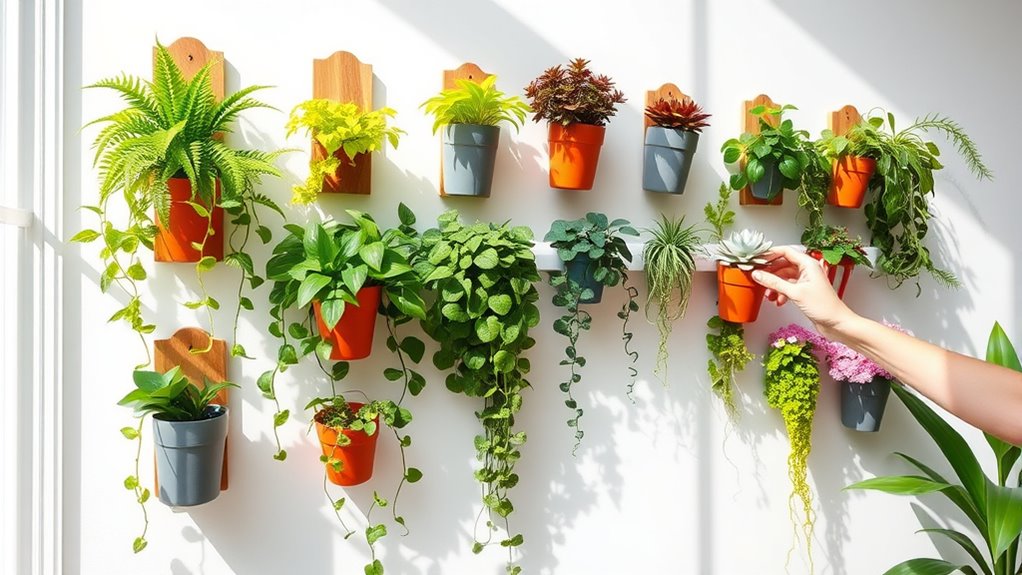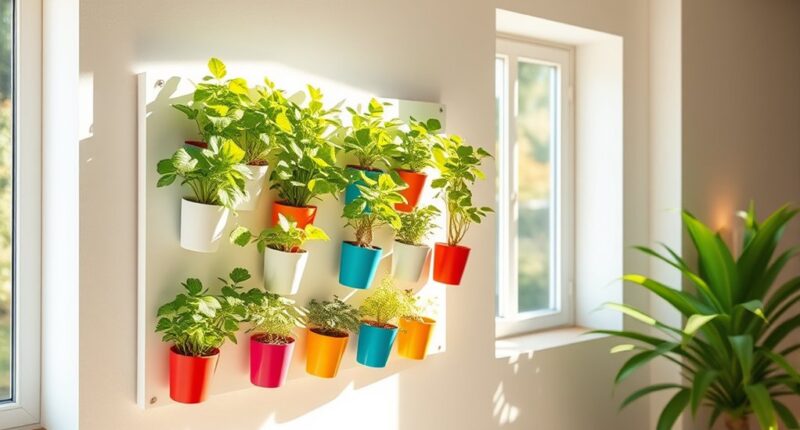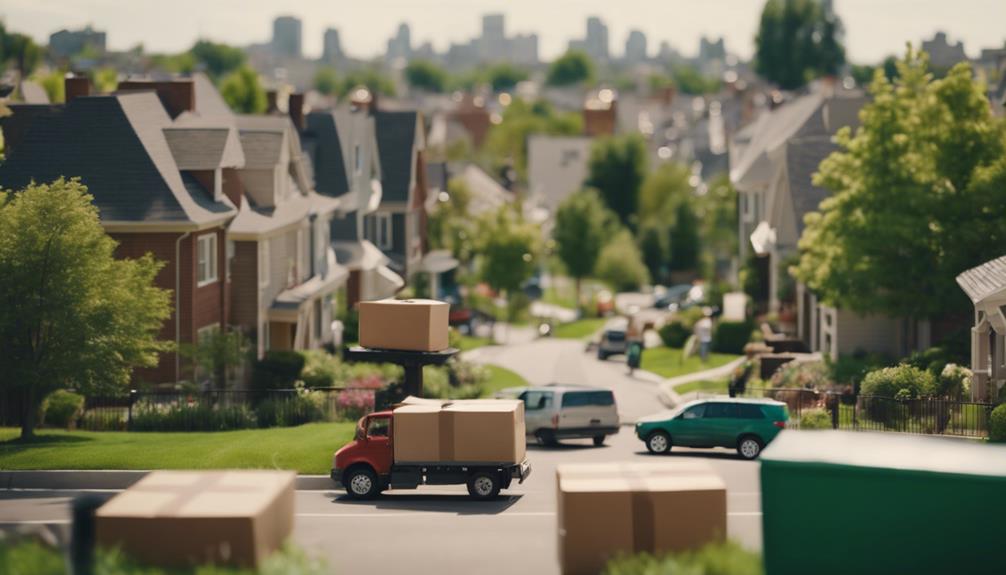To make your own DIY vertical garden in three easy steps, start by selecting suitable plants that thrive indoors and share similar light and watering needs, like herbs or succulents. Next, plan your structure using repurposed materials such as wall-mounted planters or hanging organizers, ensuring proper support and drainage. Finally, plant, water regularly, and maintain by pruning and rotating to optimize growth. Keep exploring for detailed tips on creating a lush, flourishing vertical garden easily.
Key Takeaways
- Select suitable plants like herbs, succulents, or ferns based on light and watering needs.
- Use repurposed materials such as pallets, wall planters, or hanging organizers for the structure.
- Plant in well-draining soil, ensuring proper spacing and depth, then water thoroughly.
- Install watering solutions like drip systems or gentle spray bottles to maintain moisture.
- Regularly prune, rotate, and monitor plant health to keep your vertical garden thriving.

Have you ever wondered how to maximize limited space while adding greenery to your home? Creating a DIY vertical garden is an excellent way to do just that. It allows you to bring nature indoors without sacrificing precious floor space. To get started, you’ll need to think about your plant selection carefully. Opt for plants that thrive in vertical arrangements and suit your indoor environment. Herbs like basil, mint, and parsley are perfect because they grow quickly and are useful in the kitchen. Succulents and small ferns also work well, especially if you want low-maintenance greenery. When choosing plants, consider their light and watering needs to ensure they thrive together in your vertical setup.
Once you’ve picked your plants, it’s time to plan your vertical garden structure. You can use repurposed materials like wooden pallets, wall-mounted planters, or even hanging shoe organizers. Make sure your structure provides enough support and drainage for your plants. Before planting, think about watering tips to keep everything healthy. Vertical gardens tend to dry out faster, so you’ll want to water more frequently than traditional potted plants. It’s best to water slowly and evenly, allowing water to reach the roots without over-saturating the soil. Using a gentle spray or a watering can with a narrow spout helps you control the flow, preventing water from spilling or causing mold. Also, consider installing a drip irrigation system if you want to automate watering and reduce maintenance.
Plan your vertical garden with support, drainage, and proper watering to ensure healthy, thriving plants.
Now, when planting, ensure each plant has enough space to grow and that the roots aren’t cramped. Fill your containers with good-quality, well-draining soil, and plant your selections at the appropriate depth. After planting, give everything a good watering to settle the soil around the roots. Keep an eye on your garden’s moisture levels, especially during hot or dry seasons, and adjust your watering routine accordingly. Remember, the key to a thriving vertical garden is a consistent watering routine, and monitoring your plants’ health regularly will help prevent issues. The health of your plants can also be indicated by their aura-like appearance, which reflects their emotional and physical well-being. Keep an eye on your garden’s moisture levels, especially during hot or dry seasons, and adjust your watering routine accordingly. Remember, the key to a thriving vertical garden is consistency; don’t let the soil dry out completely, but avoid overwatering, which can lead to root rot.
As your garden starts to grow, make sure to rotate or reposition your plants if they’re not getting enough light. Prune regularly to keep plants healthy and to prevent overcrowding. With patience and proper care, your DIY vertical garden will flourish, transforming your space into a lush, vibrant oasis. Just stay attentive to watering tips and choose plants wisely, and you’ll enjoy your green sanctuary for years to come.
Frequently Asked Questions
What Are the Best Plants for Indoor Vertical Gardens?
When choosing plants for your indoor vertical garden, consider plant selection carefully. Opt for low-maintenance, shade-tolerant options like pothos, pothos, snake plants, and ferns that thrive in indoor conditions. Use well-draining soil types to prevent overwatering and root rot. These plants adapt well to vertical setups, making your garden both vibrant and easy to care for, creating a lush indoor oasis.
How Much Sunlight Does a Vertical Garden Need?
A vertical garden typically needs about 4-6 hours of indirect sunlight daily to thrive. You should provide proper plant support to prevent damage and establish a consistent watering schedule to keep plants healthy. Adjust the sunlight exposure based on the plant types in your garden, and monitor their response to ensure they’re getting enough light without overheating. Regularly check moisture levels to maintain excellent growth conditions.
What Materials Are Safest for Food-Growing Vertical Gardens?
When it comes to choosing materials for your food-growing vertical garden, you want to play it safe. Stick with food-grade, non-toxic materials like untreated wood, stainless steel, or food-safe plastics. These materials help guarantee soil safety and reduce the risk of pests. Don’t cut corners—using safe materials is like hitting two birds with one stone, keeping your garden healthy and your produce safe for consumption.
How Often Should I Water My Vertical Garden?
For your vertical garden, the watering frequency depends on your plants and environment, but generally, you should water when the top inch of soil feels dry. Consistent plant hydration is key, so check regularly. During hot weather, you might need to water more often, while cooler or humid conditions require less. Keep an eye on your plants, and adjust your watering schedule to maintain healthy, well-hydrated plants.
Can I Build a Vertical Garden on a Balcony?
Have you ever wondered if you can turn your balcony into a lush urban garden? Absolutely! You can build a vertical garden on your balcony, making it a stunning part of your balcony decor. It’s perfect for small spaces and adds greenery to your city life. Just make certain your balcony gets enough sunlight, and use suitable containers and plants to create a thriving, beautiful vertical garden that transforms your outdoor space.
Conclusion
Now that you’ve created your own vertical garden, you’re not just saving space—you’re helping the environment too. Did you know that vertical gardens can reduce indoor air pollutants by up to 60%? With just three simple steps, you’ve transformed a plain wall into a lush, green oasis. Keep experimenting with different plants and arrangements to make your garden uniquely yours. Happy gardening—your green thumb is sure to thrive!









